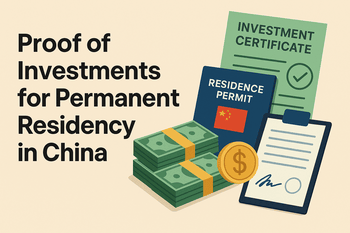
For many foreign investors looking to cultivate long-term ties with China, permanent residency represents a gateway to a vibrant business ecosystem.
Whether you’re establishing a foothold in one of the world’s most dynamic markets or seeking a secure status for personal growth, the strength of your application is determined by how well you can prove your investment.
In this guide, we examine the necessary documentation, explain regional differences, and offer actionable advice to ensure your submission stands out.
Understanding Permanent Residency in China
China’s permanent residency system has progressively evolved to accommodate investors who contribute to the nation’s continued development.
Unlike many Western immigration models, Chinese authorities demand clear, concrete evidence of a significant and sustainable investment.
For instance, many reports suggest that demonstrating an investment of USD 1 million or more in targeted sectors—ranging from green energy to advanced manufacturing—can streamline your approval process.
For additional reading on specific regional guidelines, check out the detailed guide by the Shanghai Government and Beijing’s official portal.
Why Investments Matter
Securing permanent residency in China isn’t merely about relocating—it’s about establishing a verified economic presence.
Key benefits include:
- Market Access: Simplify banking, employment, and tax proceedings.
- Operational Efficiency: Avoid the hassle of repeated visa renewals.
- Enhanced Credibility: Gain local trust as a recognized long-term investor.
Because these benefits hinge on the quality of your investment proof, ensuring that every dollar is meticulously documented is vital.
What Constitutes Proof of Investments?
Demonstrating your investment involves assembling a comprehensive portfolio of documents.
The objective is to present a transparent picture of your financial commitment.
Typical documentation includes:
- Bank Statements and Transaction Receipts: Evidence of fund transfers from personal or corporate accounts to the designated investment account in China.
- Business Registration Documents: Proof of a legally established business, such as registration certificates and tax documents.
- Appraisal and Valuation Reports: Third-party evaluations that verify the worth of your investment.
- Tax and Financial Records: Continuous records and tax returns that showcase your engagement with local economic activities.
- Contractual Agreements and Invoices: Legally binding documents such as contracts, rental agreements, and service invoices, which establish the operational nature of your investment.
To visually sum up these key documents, refer to the table below.
Table 1: Documentation Checklist for Investment Proof
| Document Type | Description | Example/Source |
|---|---|---|
| Bank Statements | Statements showing fund transfers to your Chinese investment account. | Example: Monthly transaction records |
| Business Registration | Official registration documents, including taxation certificates and business licenses. | Invest.TEDA |
| Appraisal/Valuation Reports | Third-party documents verifying the financial worth of your investments. | Independent auditor reports |
| Tax & Financial Records | Comprehensive records indicating tax payments and detailed financial contributions over time. | Annual tax returns |
| Contractual Agreements | Binding contracts and invoices that correlate with the operational aspects of your investment. | Rental or supply contracts |
This checklist offers clarity and ensures your application remains transparent and robust.
Regional Variations: Beijing, Shanghai, and Beyond
While the core criteria for proof of investments remain similar nationwide, local authorities in China might introduce specific requirements to align with regional economic policies.
Below is an overview of some regional differences:
Table 2: Regional Investment Requirements for Permanent Residency
| Region | Minimum Investment | Additional Documentation |
|---|---|---|
| Beijing | Investors typically require a minimum of USD 2 million in registered capital. | Detailed evidence of economic impact, including tax clearance certificates and audit reports[^3^]. |
| Shanghai | The benchmark often suggests an individual investment in the range of USD 1–2 million. | Multiple copies of registration certificates, passport, visa, and detailed investment receipts[^2^]. |
| Other Regions (e.g., Central/Western China) | Requirements may be lower (e.g., USD 500,000 to USD 1 million), varying with local policies. | Localized documentation proving sustained investment over at least three consecutive years. |
Understanding these regional differences can help tailor your documentation package and ensure compliance with local standards.
Step-by-Step Application Process
Embarking on the journey toward permanent residency doesn’t have to be overwhelming.
Here is a systematic approach to compiling and submitting your investment proof:
- Pre-Application Research:
Investigate the specific requirements for your target region. Official websites, such as those for Beijing and Shanghai, and consultations with professional immigration experts can provide the latest updates. - Compile Your Documents:
Organize all your financial and business records—bank statements, registration documents, contracts, and valuation reports. For documents that are not in Chinese, ensure properly translated copies are available. - Professional Assessment:
Utilize a certified valuation service to endorse your investment’s value. An independent appraisal lends credibility that goes a long way in strengthening your case. - Complete the Application Form:
Fill out the permanent residency form meticulously. Double-check details to avoid errors that might otherwise delay the process. - Submission and Follow-Up:
Submit your application along with your organized documentation. Stay prepared for follow-up questions or requests for additional proof. In some cases, an in-person interview may be required. - Legal Assistance:
Given dynamic regulations, retaining a legal expert in immigration matters can safeguard against misinterpretation of guidelines and ensure that your submission meets all criteria.
Addressing Common Challenges
Even the best-prepared applications may face hurdles. Here are some common challenges and how to overcome them:
- Precision is Key:
Every figure must correlate across documents. Inconsistencies between bank transactions and valuation reports can lead to delays or rejections. - Consistency in Documentation:
Ensure your records maintain consistency—for example, matching dates and amounts across tax returns, invoices, and contracts. - Clear Audit Trail:
Present a clear timeline of fund transfers and investment flows. A well-maintained audit trail, possibly showcased in a detailed ledger or table, can significantly boost confidence in your application. - Regional Consultant Insight:
Leverage local advisory services for tailored guidance on regional nuances. This step is particularly helpful when preparing documentation specific to Beijing or Shanghai standards.
Best Practices for a Successful Application
Excellence in documentation guarantees clarity and builds a convincing case.
Consider these best practices:
- Keep Exhaustive Financial Records:
Maintain continuous logs of all transactions. Updated documents beyond the initial application period can further validate your ongoing commitment. - Retain Professional Assistance:
Rely on legal experts and financial consultants who specialize in Chinese immigration. Their insights often help identify and address potential discrepancies before submission. - Utilize Digital Tools:
Digitally scan and securely store all documents. Backup copies can serve as a swift response in the event additional documentation is requested. - Maintain Transparency:
An upfront, transparent presentation of your investment details not only enhances credibility with immigration authorities but also signifies your genuine commitment to contributing to China’s economy. - Regularly Review Local Policies:
Stay tuned with official government sources for any changes in regulations. What qualifies today might differ in the near future.
Sources and Further Reading
For deeper insights into the documentation and regional guidelines, these trusted sources and external links provide detailed, up-to-date advice:
- Permanent Residence for Foreign Investors – Shanghai
- Foreigners Applying for Permanent Residence – Beijing
- Additional details can also be found on specialized investment websites and government portals dedicated to foreign investment policies in China.
These sources not only reinforce the guidelines outlined in this post but also offer additional context and procedural updates that can be invaluable during your application process.
Final Thoughts
Acquiring permanent residency in China through investment is both an exciting opportunity and a regulated process.
Your success is largely determined by the clarity and comprehensiveness of your investment proof.
With careful preparation, professional advice, and a well-organized document portfolio, you can confidently navigate the complexities of the application process.
Remember, your investment isn’t just measured in monetary value—instead, it is a testament to your commitment to contributing to one of the world’s most influential markets.
Beyond the numbers, demonstrating transparency and consistency will form the backbone of a compelling application.
As you prepare your application, consider exploring additional topics such as “Navigating Local Investment Policies in China” and “Leveraging Business Investments for Long-Term Residency Benefits.”
These subjects can further expand your understanding and empower you on your journey.


